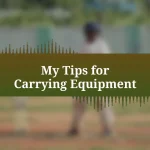Key takeaways:
- The right cricket gear, including footwear and protective equipment, is critical for performance and injury prevention.
- Adapting gear to specific weather conditions can significantly enhance gameplay, such as using moisture-wicking clothing and proper spikes for different surfaces.
- Regular maintenance and proper fitting of equipment are essential to avoid distractions and ensure optimal performance during matches.
Author: Evelyn Harper
Bio: Evelyn Harper is an award-winning author known for her evocative storytelling and rich character development. With a background in psychology, she weaves intricate narratives that explore the complexities of human relationships. Her debut novel, “Whispers in the Wind,” received critical acclaim and established her as a fresh voice in contemporary fiction. A graduate of the Iowa Writers’ Workshop, Evelyn resides in Portland, Oregon, where she continues to write and inspire aspiring authors through workshops and mentorship. When not immersed in her writing, she enjoys hiking the Pacific Northwest trails and sipping coffee at local cafes.
Understanding cricket gear essentials
Cricket gear essentials can truly make or break your game. I remember a match where I forgot to pack my supportive batting gloves. The discomfort was distracting, making each swing feel like a gamble. Have you ever been caught in a similar situation? It’s moments like those that really highlight the importance of having the right equipment, tailored to your style and the conditions you’re playing in.
When I first started playing, I didn’t fully grasp the significance of selecting the right footwear. I wore basic sneakers thinking they were sufficient. After a slip on the pitch that nearly cost me a solid catch, I learned the hard way just how crucial proper cricket shoes are. They provide the traction needed to run swiftly and pivot without hesitation, essential for both fielders and batsmen.
Protective gear is another vital aspect of my cricket arsenal. The first time I was hit on my pads without a quality thigh guard, I realized just how painful the game could get. Now, I meticulously check my protective gear before each match. I often ask myself, “Am I fully equipped to prevent injury?” Embracing the right gear not only affects your performance but your comfort on the field, allowing you to focus solely on the game.
Importance of adapting gear
Adapting my gear to different weather conditions is essential for optimal performance. I recall a match where the sun was beating down relentlessly. Without my moisture-wicking shirt, I found myself drenched in sweat and increasingly exhausted. It was a stark reminder of how the right fabric can significantly impact your energy and ability to concentrate on your game.
When the ground is wet, I’ve learned the hard way that wearing the correct type of spikes can change everything. There was a match where I opted for standard shoes instead of my specialized wet-weather cleats. The result? I slipped during a critical moment while fielding, leading to an easy boundary for the opponents. This experience emphasized that each match has its unique requirements, and being prepared can mitigate critical mistakes on the field.
I also adjust my protective gear based on the opposition’s bowling style. I once faced a genuinely fast bowler who made me reconsider my usual helmet choice. Switching to a more rigid model gave me a sense of security and confidence, allowing me to focus on my batting technique rather than worrying about taking a hard hit. Have you ever had to rethink your setup to gain that extra edge? Adapting your gear is about feeling empowered while you play, and it truly can be the difference between a good game and a great one.
Common playing conditions in cricket
When playing cricket, the weather can be a major player in the match. On a sweltering day, I once underestimated the importance of hydration and lightweight gear. By the fifth over, I felt sluggish and slow, wishing I had opted for a more breathable kit rather than my usual heavy attire. It made me acutely aware of how crucial it is to consider climate conditions before stepping onto the pitch.
Another key aspect is the ground itself. For instance, during a rainy spell, I remember a match where the outfield was muddy and uneven. I had a moment of panic when I misjudged my footing and nearly fell while attempting to chase down a ball. Using the right stud pattern on my shoes makes a world of difference. Have you ever considered how the field itself can dictate the gear you wear? It’s fascinating how adapting to the playing surface can improve not just your performance but your confidence too.
Then there’s the challenge of adjusting to sunlight. In one particular game, the glare was so intense that it became nearly impossible to see the ball clearly. I realized the value of wearing tinted sunglasses designed for sports—that small change turned my game around. It’s interesting how sometimes the simplest adjustments can elevate your performance and make you feel more in control.
How weather affects gear choice
Weather significantly influences how I choose my gear, and I’ve learned this through trial and error. On particularly windy days, I’ve noticed that wearing a snug-fitting cap can make a huge difference. There were times when an unsteady hat would fly off during my run-up, completely throwing me off my game. Have you faced similar distractions on breezy days?
Humidity also carries its weight in gear selection. In a humid match, I once found myself drenched in sweat, leading to a loss of grip on my bat. That experience taught me to prioritize moisture-wicking clothing, which not only keeps me comfortable but enhances my control over the equipment. It’s intriguing how something as simple as the right fabric for the weather can elevate my performance so significantly.
Then there’s the cold. I remember a match in chilly conditions where I regretted not wearing gloves. My fingers were so stiff that swinging the bat felt awkward and uncomfortable. Now, I always pack thermal layers for those brisk days, ensuring I can focus on my technique rather than trying to warm up my hands. It’s a clear reminder that when I adapt my gear to match the weather, I get to play my best cricket.
My personal gear adaptation strategies
When it comes to adjusting my gear, I’ve found that footwear is crucial in varying conditions. For instance, after slipping during a match on a muddy pitch, I invested in cleats specifically designed for poor conditions. The confidence I gained from maintaining grip while bowling was a game changer. Have you ever felt that knot of uncertainty with each step on a slippery field?
In terms of visibility, I can’t stress enough how important it is to tweak my gear based on the time of day. During a recent early morning match, I struggled to track the ball during dawn light, which inspired me to buy a pair of brightly colored gloves. The added visibility not only helped me react faster but also changed my approach to playing under different lighting. It’s fascinating how a simple color change can impact focus on the field.
Then there’s the issue of temperature regulation. I vividly remember a scorching afternoon when I felt like I was melting under my standard cricket shirt. Swapping to a lightweight, breathable jersey transformed my experience, reducing the fatigue I often faced. Do you have a go-to shirt for hot days? Finding that perfect piece made all the difference, allowing me to enjoy the game instead of battling the heat.
Example adaptations for wet conditions
When it rains, one of my greatest adaptations is ensuring I have a reliable moisture-wicking base layer. I still recall a match where I got drenched, and the soaked cotton shirt clung to my skin uncomfortably. Since then, I’ve switched to synthetic fabrics that dry quickly, which dramatically improves my comfort and keeps my focus on the game instead of my soggy attire. Ever faced that annoying distraction of a heavy shirt weighing you down?
A key gear adjustment for wet conditions involves having an extra pair of gloves. During a particularly rainy day, I found my grips slipping constantly, and it really threw off my performance. I learned the hard way that having a spare, dry pair tucked in my kit allows me to quickly switch when needed, enhancing my confidence with every catch. It’s surprising how much a simple swap can elevate your play when conditions are less than favorable.
Lastly, considering my bat’s protection during downpours is critical. I remember a scenario where I inadvertently left my bat exposed, and the moisture warped the handle. Now, I always ensure I have a good-quality bat cover that protects it from the rain, allowing me to take the field without worrying about my equipment. What adaptations have you made to safeguard your gear during wet matches?
Tips for optimizing gear performance
One tip for optimizing gear performance is to regularly check and maintain your equipment. I remember a time when I neglected to inspect my pads, only to realize during a match that the velcro straps were barely holding on. It was embarrassing and affected my mobility. Now, I make it a point to adjust and check everything before every game, which gives me peace of mind and allows me to focus on my game rather than my gear.
Don’t underestimate the importance of proper fitting gear. I learned this the hard way when I mistakenly played with a pair of ill-fitting shoes that caused blisters, impacting my movement on the field. Since then, I’ve invested time in finding gear that fits well and feels like an extension of my body. Ensuring everything fits correctly not only enhances performance but also significantly boosts confidence.
Another effective strategy is to customize your gear for specific conditions. For instance, when I play with a heavier bat during windy days, I adjust my grip to ensure better control. Have you ever tried modifying your equipment based on the conditions? I found that it makes a noticeable difference in how I handle different situations, helping me stay ahead in the game.



